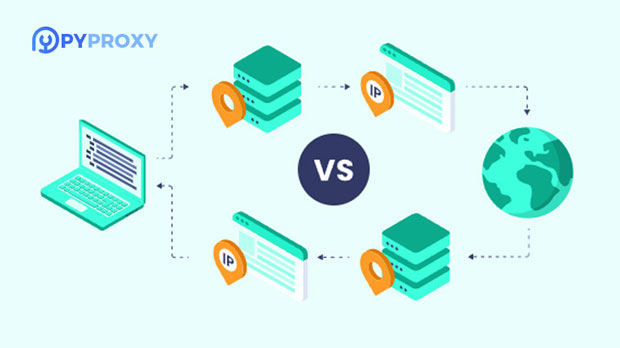In today's fast-evolving digital landscape, proxies have become an essential tool for maintaining privacy, bypassing geo-restrictions, and enhancing network security. Among the different types of proxies, sock s5 proxies stand out due to their flexibility and security features. However, when it comes to using tools like PYPROXY unblock proxy, a question often arises: Does it seamlessly integrate with common SOCKS5 application scenarios? This article delves into the compatibility of PyProxy unblock proxy with typical SOCKS5 use cases, analyzing its functionality, advantages, and limitations to help users understand whether it's the right tool for their needs. Introduction to PyProxy Unblock Proxy and SOCKS5PyProxy unblock proxy is a tool designed to circumvent restrictions on network traffic, ensuring seamless and secure browsing or data exchange. SOCKS5, on the other hand, is a widely-used proxy protocol that supports a broad range of applications, including online gaming, torrenting, and secure browsing. The real challenge lies in determining how well these two technologies integrate with each other, especially in terms of performance, security, and application compatibility.What is SOCKS5 and How Does It Work?SOCKS5 is an advanced version of the SOCKS protocol, designed to provide users with better security, speed, and versatility. Unlike HTTP or HTTPS proxies, which are limited to specific types of traffic, SOCKS5 works at a lower level in the network stack, allowing it to handle all kinds of traffic, including HTTP, FTP, and even peer-to-peer protocols.One of the key features of SOCKS5 is its ability to support both IPv4 and IPv6 addresses, making it highly compatible with modern internet protocols. Additionally, SOCKS5 supports authentication, which adds an extra layer of security, ensuring that only authorized users can access the proxy.Understanding PyProxy Unblock ProxyPyProxy unblock proxy is a versatile tool designed to work with various proxy protocols, including SOCKS5. Its primary function is to bypass internet restrictions, ensuring that users can access blocked content or websites. It supports several methods of unblocking, such as through proxy chains or VPNs, allowing users to route their traffic through different servers to mask their true location.While PyProxy unblock proxy is effective at evading restrictions, its integration with SOCKS5 proxies depends on several factors, such as the application scenario and the specific configuration of both the tool and the proxy.Common Use Cases for SOCKS5 ProxiesTo understand whether PyProxy unblock proxy is compatible with SOCKS5, it's essential to examine some of the common use cases for SOCKS5 proxies:1. Anonymous Browsing: Many users rely on SOCKS5 proxies to hide their IP addresses while surfing the web. This helps protect their privacy and avoid surveillance.2. Torrenting: SOCKS5 is frequently used in torrenting to anonymize the user's connection and bypass geo-restrictions on content.3. Online Gaming: In online gaming, SOCKS5 proxies are used to reduce lag, avoid DDoS attacks, and access region-restricted servers.4. Accessing Geo-restricted Content: Users also utilize SOCKS5 proxies to unblock content that is restricted based on geographical location, such as streaming services.5. Bypassing Censorship: In countries with strict internet censorship, SOCKS5 proxies provide an effective means of bypassing government restrictions.Compatibility of PyProxy Unblock Proxy with SOCKS5 Use CasesNow that we have a clear understanding of SOCKS5 and PyProxy unblock proxy, it’s time to assess their compatibility in the context of these common use cases.1. Anonymous Browsing: PyProxy unblock proxy works well with SOCKS5 for anonymous browsing. Both technologies aim to mask the user's IP address, ensuring that web activity remains private. PyProxy’s ability to work with SOCKS5 proxies ensures that users can access the web without revealing their real IP address, making it a suitable choice for those seeking anonymity. 2. Torrenting: When it comes to torrenting, PyProxy unblock proxy is highly compatible with SOCKS5. Many torrent clients, such as uTorrent and BitTorrent, allow users to configure SOCKS5 proxies for enhanced privacy. By routing traffic through a socks5 proxy, users can download and upload torrents anonymously, bypassing any geo-blocks or bandwidth throttling imposed by their internet service provider. PyProxy supports this functionality, making it a strong choice for torrent users.3. Online Gaming: Online gamers who wish to avoid DDoS attacks or reduce lag may find that PyProxy unblock proxy works well with SOCKS5. It allows gamers to connect to remote servers without exposing their real IP address, providing an added layer of security. However, depending on the configuration, some gaming platforms may not recognize the SOCKS5 proxy correctly, which can lead to performance issues. In most cases, though, PyProxy can optimize the gaming experience by minimizing lag and enhancing security.4. Accessing Geo-restricted Content: SOCKS5 proxies are often used to bypass geo-restrictions, particularly in the case of streaming services. PyProxy unblock proxy is compatible with this use case, allowing users to access content that would otherwise be unavailable in their region. However, some streaming services may employ anti-proxy measures that can detect and block the use of proxies. In these cases, PyProxy unblock proxy can help circumvent such restrictions by continuously rotating IP addresses and masking the user’s traffic.5. Bypassing Censorship: In regions with heavy internet censorship, SOCKS5 proxies offer a reliable method for bypassing government-imposed restrictions. PyProxy unblock proxy can facilitate this by routing traffic through different proxy servers, ensuring that users maintain access to the internet. However, users should be aware that some governments may actively block proxy servers, and in such cases, PyProxy may need to utilize advanced proxy rotation techniques to maintain access.In conclusion, PyProxy unblock proxy demonstrates good compatibility with the most common SOCKS5 application scenarios, including anonymous browsing, torrenting, online gaming, accessing geo-restricted content, and bypassing censorship. However, its effectiveness depends on several factors, including the specific configurations of both the tool and the proxy. While PyProxy is generally a reliable solution for users looking to enhance privacy and bypass restrictions, it’s important for users to understand the limitations and ensure proper setup to achieve optimal performance.
Sep 01, 2025



































































